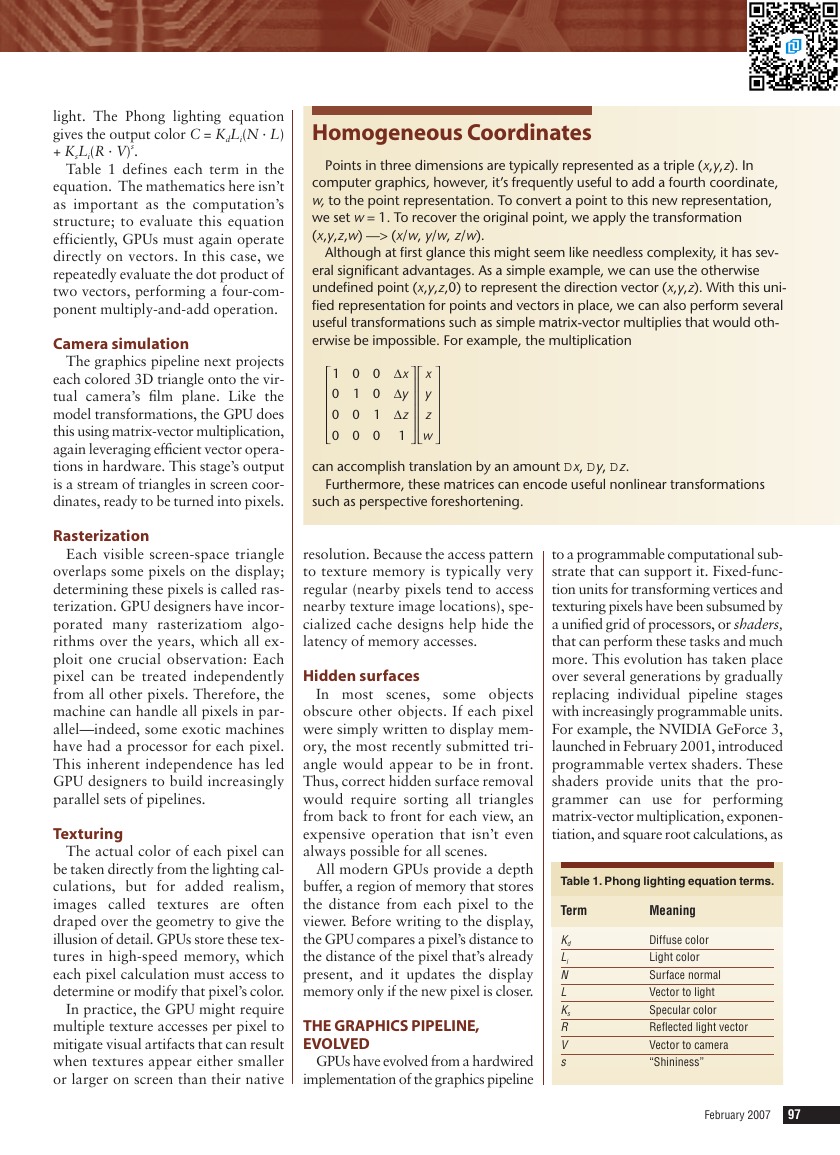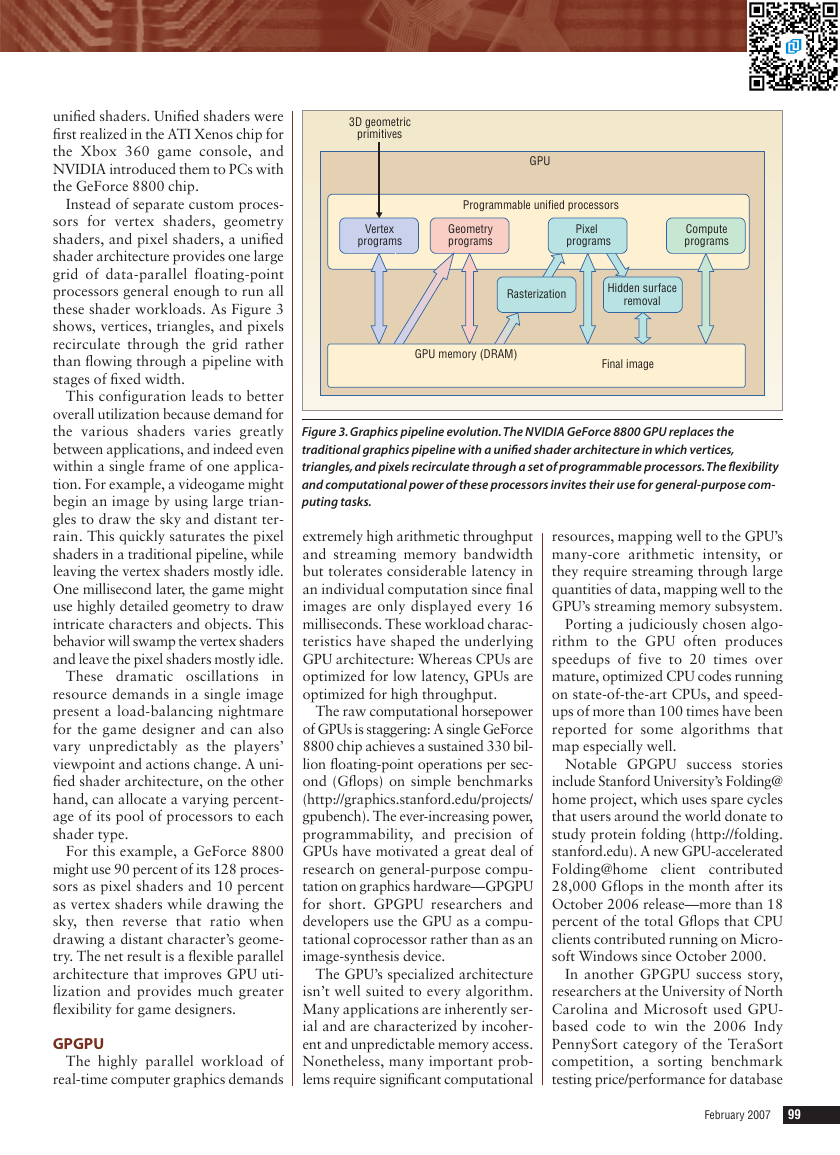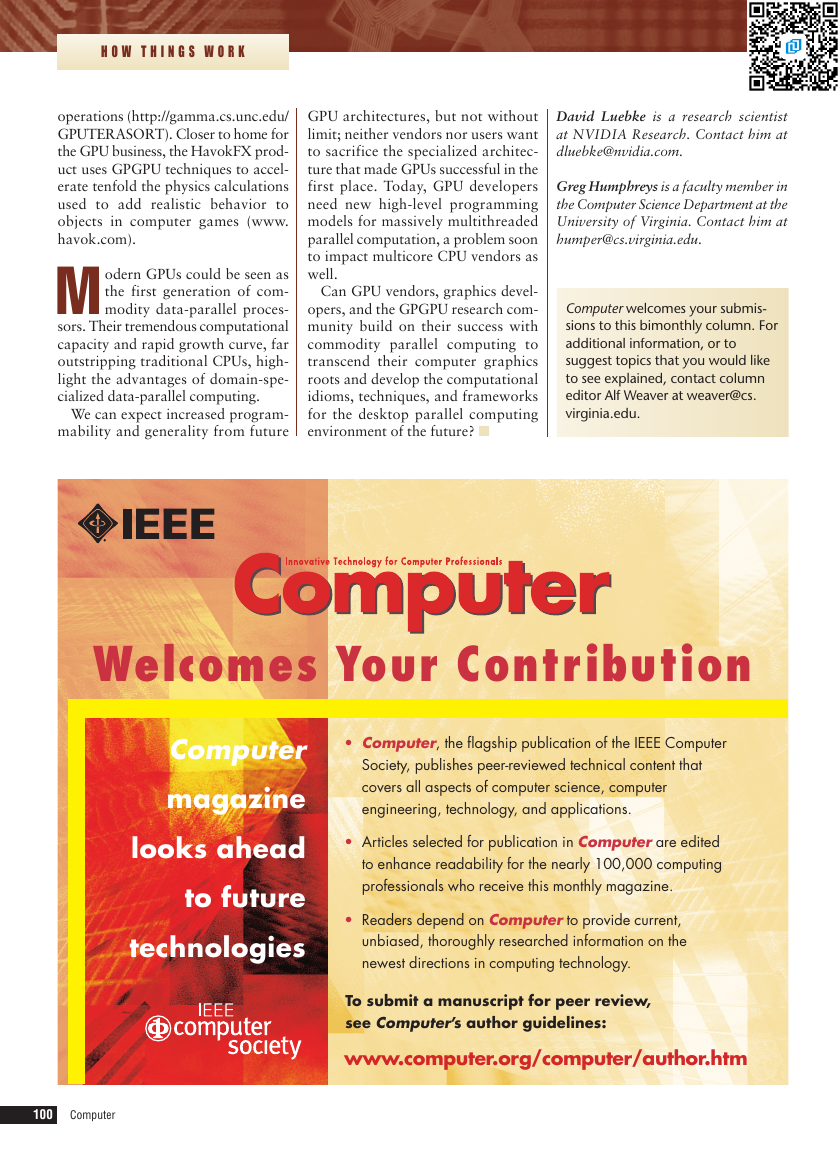H O W T H I N G S W O R K
How GPUs
Work
David Luebke, NVIDIA Research
Greg Humphreys, University of Virginia
GPUs have moved away from
the traditional fixed-function
3D graphics pipeline toward
a flexible general-purpose
computational engine.
I n the early 1990s, ubiquitous
interactive 3D graphics was still
the stuff of science fiction. By the
end of the decade, nearly every
new computer contained a graph-
ics processing unit (GPU) dedicated to
providing a high-performance, visu-
ally rich, interactive 3D experience.
This dramatic shift was the in-
evitable consequence of consumer
demand for videogames, advances in
manufacturing technology, and the
exploitation of the inherent paral-
lelism in the feed-forward graphics
pipeline. Today, the raw computa-
tional power of a GPU dwarfs that of
the most powerful CPU, and the gap is
steadily widening.
Furthermore, GPUs have moved
away from the traditional fixed-func-
tion 3D graphics pipeline toward
a flexible general-purpose compu-
tational engine. Today, GPUs can
implement many parallel algorithms
directly using graphics hardware.
Well-suited algorithms that leverage
all the underlying computational
horsepower often achieve tremendous
speedups. Truly, the GPU is the first
widely deployed commodity desktop
parallel computer.
96
Computer
THE GRAPHICS PIPELINE
The task of any 3D graphics system
is to synthesize an image from a
description of a scene—60 times per
second for real-time graphics such as
videogames. This scene contains the
geometric primitives to be viewed as
well as descriptions of the lights illu-
minating the scene, the way that each
object reflects light, and the viewer’s
position and orientation.
GPU designers traditionally have
expressed this image-synthesis process
as a hardware pipeline of specialized
stages. Here, we provide a high-level
overview of the classic graphics
pipeline; our goal is to highlight those
aspects of the real-time rendering cal-
culation that allow graphics applica-
tion developers to exploit modern
GPUs as general-purpose parallel
computation engines.
Pipeline input
Most real-time graphics systems
assume that everything is made of tri-
angles, and they first carve up any more
complex shapes, such as quadrilaterals
or curved surface patches, into trian-
gles. The developer uses a computer
graphics library (such as OpenGL or
Direct3D) to provide each triangle to
the graphics pipeline one vertex at a
time; the GPU assembles vertices into
triangles as needed.
Model transformations
A GPU can specify each logical
object in a scene in its own locally
defined coordinate system, which is
convenient for objects that are natu-
rally defined hierarchically. This con-
venience comes at a price: before
rendering, the GPU must first trans-
form all objects into a common coor-
dinate system. To ensure that triangles
aren’t warped or twisted into curved
shapes, this transformation is limited
to simple affine operations such as
rotations, translations, scalings, and
the like.
As the “Homogeneous Coordinates”
sidebar explains, by representing each
vertex in homogeneous coordinates,
the graphics system can perform the
entire hierarchy of transformations
simultaneously with a single matrix-
vector multiply. The need for efficient
hardware to perform floating-point
vector arithmetic for millions of ver-
tices each second has helped drive the
GPU parallel-computing revolution.
The output of this stage of the
pipeline is a stream of triangles, all
expressed in a common 3D coordinate
system in which the viewer is located
at the origin, and the direction of view
is aligned with the z-axis.
Lighting
Once each triangle is in a global
coordinate system, the GPU can com-
pute its color based on the lights in the
scene. As an example, we describe the
calculations for a single-point light
source (imagine a very small lightbulb).
The GPU handles multiple lights by
summing the contributions of each
individual light. The traditional graph-
ics pipeline supports the Phong light-
ing equation (B-T. Phong, “Illumina-
tion for Computer-Generated Images,”
Comm. ACM, June 1975, pp. 311-
317), a phenomenological appearance
model that approximates the look of
plastic. These materials combine a dull
diffuse base with a shiny specular high-
�
light. The Phong lighting equation
gives the output color C = KdLi(N · L)
+ KsLi(R · V)s.
Table 1 defines each term in the
equation. The mathematics here isn’t
as important as the computation’s
structure; to evaluate this equation
efficiently, GPUs must again operate
directly on vectors. In this case, we
repeatedly evaluate the dot product of
two vectors, performing a four-com-
ponent multiply-and-add operation.
Camera simulation
The graphics pipeline next projects
each colored 3D triangle onto the vir-
tual camera’s film plane. Like the
model transformations, the GPU does
this using matrix-vector multiplication,
again leveraging efficient vector opera-
tions in hardware. This stage’s output
is a stream of triangles in screen coor-
dinates, ready to be turned into pixels.
Rasterization
Each visible screen-space triangle
overlaps some pixels on the display;
determining these pixels is called ras-
terization. GPU designers have incor-
porated many rasterizatiom algo-
rithms over the years, which all ex-
ploit one crucial observation: Each
pixel can be treated independently
from all other pixels. Therefore, the
machine can handle all pixels in par-
allel—indeed, some exotic machines
have had a processor for each pixel.
This inherent independence has led
GPU designers to build increasingly
parallel sets of pipelines.
Texturing
The actual color of each pixel can
be taken directly from the lighting cal-
culations, but for added realism,
images called textures are often
draped over the geometry to give the
illusion of detail. GPUs store these tex-
tures in high-speed memory, which
each pixel calculation must access to
determine or modify that pixel’s color.
In practice, the GPU might require
multiple texture accesses per pixel to
mitigate visual artifacts that can result
when textures appear either smaller
or larger on screen than their native
Homogeneous Coordinates
Points in three dimensions are typically represented as a triple (x,y,z). In
computer graphics, however, it’s frequently useful to add a fourth coordinate,
w, to the point representation. To convert a point to this new representation,
we set w = 1. To recover the original point, we apply the transformation
(x,y,z,w) —> (x/w, y/w, z/w).
Although at first glance this might seem like needless complexity, it has sev-
eral significant advantages. As a simple example, we can use the otherwise
undefined point (x,y,z,0) to represent the direction vector (x,y,z). With this uni-
fied representation for points and vectors in place, we can also perform several
useful transformations such as simple matrix-vector multiplies that would oth-
erwise be impossible. For example, the multiplication
⎡
⎢
⎢
⎢
⎢
⎣
1 0 0 Δx
0 1 0 Δy
0 0 1 Δz
1
0 0 0
⎤
⎥
⎥
⎥
⎥
⎦
⎡
⎢
⎢
⎢
⎢
⎣
x
y
z
w
⎤
⎥
⎥
⎥
⎥
⎦
can accomplish translation by an amount Dx, Dy, Dz.
Furthermore, these matrices can encode useful nonlinear transformations
such as perspective foreshortening.
resolution. Because the access pattern
to texture memory is typically very
regular (nearby pixels tend to access
nearby texture image locations), spe-
cialized cache designs help hide the
latency of memory accesses.
Hidden surfaces
In most scenes, some objects
obscure other objects. If each pixel
were simply written to display mem-
ory, the most recently submitted tri-
angle would appear to be in front.
Thus, correct hidden surface removal
would require sorting all triangles
from back to front for each view, an
expensive operation that isn’t even
always possible for all scenes.
All modern GPUs provide a depth
buffer, a region of memory that stores
the distance from each pixel to the
viewer. Before writing to the display,
the GPU compares a pixel’s distance to
the distance of the pixel that’s already
present, and it updates the display
memory only if the new pixel is closer.
THE GRAPHICS PIPELINE,
EVOLVED
GPUs have evolved from a hardwired
implementation of the graphics pipeline
to a programmable computational sub-
strate that can support it. Fixed-func-
tion units for transforming vertices and
texturing pixels have been subsumed by
a unified grid of processors, or shaders,
that can perform these tasks and much
more. This evolution has taken place
over several generations by gradually
replacing individual pipeline stages
with increasingly programmable units.
For example, the NVIDIA GeForce 3,
launched in February 2001, introduced
programmable vertex shaders. These
shaders provide units that the pro-
grammer can use for performing
matrix-vector multiplication, exponen-
tiation, and square root calculations, as
Table 1. Phong lighting equation terms.
Term
Meaning
Kd
Li
N
L
Ks
R
V
s
Diffuse color
Light color
Surface normal
Vector to light
Specular color
Reflected light vector
Vector to camera
“Shininess”
February 2007
97
�
H O W T H I N G S W O R K
GPUs introduced increased flexibility,
adding support for longer programs,
more registers, and control-flow prim-
itives such as branches, loops, and
subroutines.
The ATI Radeon 9700 (July 2002)
and NVIDIA GeForce FX (January
2003) replaced the often awkward reg-
ister combiners with fully program-
mable pixel shaders. NVIDIA’s latest
chip, the GeForce 8800 (November
2006), adds programmability to the
primitive assembly stage, allowing
developers to control how they con-
struct triangles from transformed ver-
tices. As Figure 2 shows, modern
GPUs achieve stunning visual realism.
Increases in precision have accom-
panied increases in programmability.
The traditional graphics pipeline pro-
vided only 8-bit integers per color
channel, allowing values ranging from
0 to 255. The ATI Radeon 9700
increased the representable range of
color to 24-bit floating point, and
NVIDIA’s GeForce FX followed with
both 16-bit and 32-bit floating point.
Both vendors have announced plans
to support 64-bit double-precision
floating point in upcoming chips.
To keep up with the relentless
demand for graphics performance,
GPUs have aggressively embraced
parallel design. GPUs have long used
four-wide vector registers much like
Intel’s Streaming SIMD Extensions
(SSE) instruction sets now provide on
Intel CPUs. The number of such four-
wide processors executing in parallel
has increased as well, from only four
on GeForce FX to 16 on GeForce
6800 (April 2004) to 24 on GeForce
7800 (May 2005). The GeForce 8800
actually includes 128 scalar shader
processors that also run on a special
shader clock at 2.5 times the clock
rate (relative to pixel output) of for-
mer chips, so the computational per-
formance might be considered equiv-
alent to 128 ¥ 2.5/4 = 80 four-wide
pixel shaders.
UNIFIED SHADERS
The latest step in the evolution from
hardwired pipeline to flexible compu-
tational fabric is the introduction of
Figure 1. Programmable shading.The introduction of programmable shading in 2001 led
to several visual effects not previously possible, such as this simulation of refractive
chromatic dispersion for a “soap bubble” effect.
Figure 2. Unprecedented visual realism. Modern GPUs can use programmable shading to
achieve near-cinematic realism, as this interactive demonstration shows, featuring
actress Adrianne Curry on an NVIDIA GeForce 8800 GTX.
well as a short default program that
uses these units to perform vertex trans-
formation and lighting.
GeForce 3 also introduced limited
reconfigurability into pixel processing,
exposing the texturing hardware’s
functionality as a set of register com-
biners that could achieve novel visual
effects such as the “soap-bubble” look
demonstrated in Figure 1. Subsequent
98
Computer
�
unified shaders. Unified shaders were
first realized in the ATI Xenos chip for
the Xbox 360 game console, and
NVIDIA introduced them to PCs with
the GeForce 8800 chip.
Instead of separate custom proces-
sors for vertex shaders, geometry
shaders, and pixel shaders, a unified
shader architecture provides one large
grid of data-parallel floating-point
processors general enough to run all
these shader workloads. As Figure 3
shows, vertices, triangles, and pixels
recirculate through the grid rather
than flowing through a pipeline with
stages of fixed width.
This configuration leads to better
overall utilization because demand for
the various shaders varies greatly
between applications, and indeed even
within a single frame of one applica-
tion. For example, a videogame might
begin an image by using large trian-
gles to draw the sky and distant ter-
rain. This quickly saturates the pixel
shaders in a traditional pipeline, while
leaving the vertex shaders mostly idle.
One millisecond later, the game might
use highly detailed geometry to draw
intricate characters and objects. This
behavior will swamp the vertex shaders
and leave the pixel shaders mostly idle.
in
resource demands in a single image
present a load-balancing nightmare
for the game designer and can also
vary unpredictably as the players’
viewpoint and actions change. A uni-
fied shader architecture, on the other
hand, can allocate a varying percent-
age of its pool of processors to each
shader type.
These dramatic oscillations
For this example, a GeForce 8800
might use 90 percent of its 128 proces-
sors as pixel shaders and 10 percent
as vertex shaders while drawing the
sky, then reverse that ratio when
drawing a distant character’s geome-
try. The net result is a flexible parallel
architecture that improves GPU uti-
lization and provides much greater
flexibility for game designers.
GPGPU
The highly parallel workload of
real-time computer graphics demands
3D geometric
primitives
GPU
Programmable unified processors
Vertex
programs
Geometry
programs
Pixel
programs
Compute
programs
Rasterization
Hidden surface
removal
GPU memory (DRAM)
Final image
Figure 3. Graphics pipeline evolution.The NVIDIA GeForce 8800 GPU replaces the
traditional graphics pipeline with a unified shader architecture in which vertices,
triangles, and pixels recirculate through a set of programmable processors.The flexibility
and computational power of these processors invites their use for general-purpose com-
puting tasks.
extremely high arithmetic throughput
and streaming memory bandwidth
but tolerates considerable latency in
an individual computation since final
images are only displayed every 16
milliseconds. These workload charac-
teristics have shaped the underlying
GPU architecture: Whereas CPUs are
optimized for low latency, GPUs are
optimized for high throughput.
The raw computational horsepower
of GPUs is staggering: A single GeForce
8800 chip achieves a sustained 330 bil-
lion floating-point operations per sec-
ond (Gflops) on simple benchmarks
(http://graphics.stanford.edu/projects/
gpubench). The ever-increasing power,
programmability, and precision of
GPUs have motivated a great deal of
research on general-purpose compu-
tation on graphics hardware—GPGPU
for short. GPGPU researchers and
developers use the GPU as a compu-
tational coprocessor rather than as an
image-synthesis device.
The GPU’s specialized architecture
isn’t well suited to every algorithm.
Many applications are inherently ser-
ial and are characterized by incoher-
ent and unpredictable memory access.
Nonetheless, many important prob-
lems require significant computational
resources, mapping well to the GPU’s
many-core arithmetic intensity, or
they require streaming through large
quantities of data, mapping well to the
GPU’s streaming memory subsystem.
Porting a judiciously chosen algo-
rithm to the GPU often produces
speedups of five to 20 times over
mature, optimized CPU codes running
on state-of-the-art CPUs, and speed-
ups of more than 100 times have been
reported for some algorithms that
map especially well.
Notable GPGPU success stories
include Stanford University’s Folding@
home project, which uses spare cycles
that users around the world donate to
study protein folding (http://folding.
stanford.edu). A new GPU-accelerated
Folding@home client contributed
28,000 Gflops in the month after its
October 2006 release—more than 18
percent of the total Gflops that CPU
clients contributed running on Micro-
soft Windows since October 2000.
In another GPGPU success story,
researchers at the University of North
Carolina and Microsoft used GPU-
based code to win the 2006 Indy
PennySort category of the TeraSort
competition, a sorting benchmark
testing price/performance for database
February 2007
99
�
H O W T H I N G S W O R K
operations (http://gamma.cs.unc.edu/
GPUTERASORT). Closer to home for
the GPU business, the HavokFX prod-
uct uses GPGPU techniques to accel-
erate tenfold the physics calculations
used to add realistic behavior to
objects in computer games (www.
havok.com).
M odern GPUs could be seen as
the first generation of com-
modity data-parallel proces-
sors. Their tremendous computational
capacity and rapid growth curve, far
outstripping traditional CPUs, high-
light the advantages of domain-spe-
cialized data-parallel computing.
We can expect increased program-
mability and generality from future
GPU architectures, but not without
limit; neither vendors nor users want
to sacrifice the specialized architec-
ture that made GPUs successful in the
first place. Today, GPU developers
need new high-level programming
models for massively multithreaded
parallel computation, a problem soon
to impact multicore CPU vendors as
well.
Can GPU vendors, graphics devel-
opers, and the GPGPU research com-
munity build on their success with
commodity parallel computing to
transcend their computer graphics
roots and develop the computational
idioms, techniques, and frameworks
for the desktop parallel computing
environment of the future? ■
David Luebke is a research scientist
at NVIDIA Research. Contact him at
dluebke@nvidia.com.
Greg Humphreys is a faculty member in
the Computer Science Department at the
University of Virginia. Contact him at
humper@cs.virginia.edu.
Computer welcomes your submis-
sions to this bimonthly column. For
additional information, or to
suggest topics that you would like
to see explained, contact column
editor Alf Weaver at weaver@cs.
virginia.edu.
Welcomes Your Contribution
Computer
magazine
looks ahead
to future
technologies
• Computer, the flagship publication of the IEEE Computer
Society, publishes peer-reviewed technical content that
covers all aspects of computer science, computer
engineering, technology, and applications.
• Articles selected for publication in Computerare edited
to enhance readability for the nearly 100,000 computing
professionals who receive this monthly magazine.
• Readers depend on Computerto provide current,
unbiased, thoroughly researched information on the
newest directions in computing technology.
To submit a manuscript for peer review,
see Computer’s author guidelines:
www.computer.org/computer/author.htm
100
Computer
�










 2023年江西萍乡中考道德与法治真题及答案.doc
2023年江西萍乡中考道德与法治真题及答案.doc 2012年重庆南川中考生物真题及答案.doc
2012年重庆南川中考生物真题及答案.doc 2013年江西师范大学地理学综合及文艺理论基础考研真题.doc
2013年江西师范大学地理学综合及文艺理论基础考研真题.doc 2020年四川甘孜小升初语文真题及答案I卷.doc
2020年四川甘孜小升初语文真题及答案I卷.doc 2020年注册岩土工程师专业基础考试真题及答案.doc
2020年注册岩土工程师专业基础考试真题及答案.doc 2023-2024学年福建省厦门市九年级上学期数学月考试题及答案.doc
2023-2024学年福建省厦门市九年级上学期数学月考试题及答案.doc 2021-2022学年辽宁省沈阳市大东区九年级上学期语文期末试题及答案.doc
2021-2022学年辽宁省沈阳市大东区九年级上学期语文期末试题及答案.doc 2022-2023学年北京东城区初三第一学期物理期末试卷及答案.doc
2022-2023学年北京东城区初三第一学期物理期末试卷及答案.doc 2018上半年江西教师资格初中地理学科知识与教学能力真题及答案.doc
2018上半年江西教师资格初中地理学科知识与教学能力真题及答案.doc 2012年河北国家公务员申论考试真题及答案-省级.doc
2012年河北国家公务员申论考试真题及答案-省级.doc 2020-2021学年江苏省扬州市江都区邵樊片九年级上学期数学第一次质量检测试题及答案.doc
2020-2021学年江苏省扬州市江都区邵樊片九年级上学期数学第一次质量检测试题及答案.doc 2022下半年黑龙江教师资格证中学综合素质真题及答案.doc
2022下半年黑龙江教师资格证中学综合素质真题及答案.doc